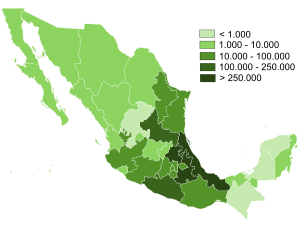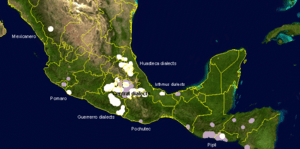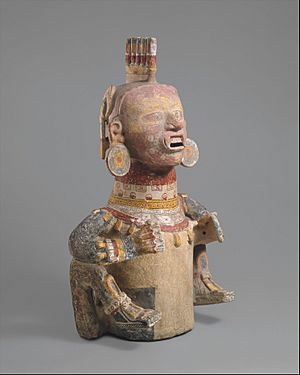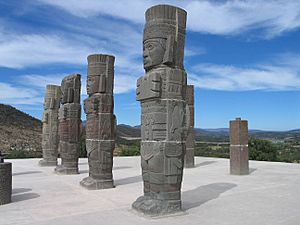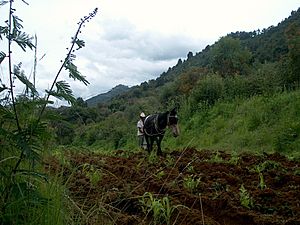Nahuas facts for kids

Flag of the Nahuas
|
|
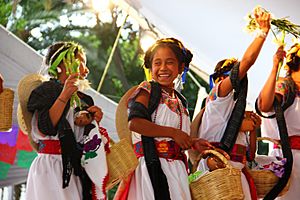
Nahua children in traditional clothes
|
|
| Total population | |
|---|---|
| 2,694,189 | |
| Regions with significant populations | |
| Mexico Oaxaca, Morelos, Puebla, Hidalgo, Michoacán, Veracruz, Jalisco, Estado de México, Distrito l, Tlaxcala, Chihuahua, Durango, San Luis Potosi and Guerrero El Salvador Ahuachapan, Sonsonate, San Salvador, Santa Ana |
|
| Languages | |
| Nahuatl, Pipil, Spanish and English | |
| Religion | |
| Christianity (Predominantly Roman Catholic with pre-Columbian influence) Aztec religion | |
| Related ethnic groups | |
| Pipil people, Mexicaneros, Indigenous people of the Americas and Mestizo |
The Nahuas are a group of native people who live in Mexico, El Salvador, Guatemala, Honduras, and Nicaragua. They are the largest native group in Mexico and the second largest in El Salvador. The famous Mexica people, also known as the Aztecs, were part of the Nahua family. The Toltecs are also thought to have been Nahua.
The Nahua people speak Nahuan languages, or Nahuatl. There are many different types of Nahuatl, and some are so different that speakers can't understand each other. About 1.5 million Nahuas speak Nahuatl, while another million speak only Spanish. In El Salvador, fewer than 1,000 people still speak Nahuatl.
It is believed that the Nahua people first came from a dry region in northern Mexico, around what is now Durango and Nayarit. They moved into central Mexico around 500 CE. The Nahua then settled in the Basin of Mexico and became a very important group in central Mexico.
Contents
What does the name "Nahua" mean?
The name Nahua comes from a Nahuatl word that means "clear" or "easy to understand." It was used to describe people who spoke clearly or spoke their own language. This was different from the word popoloca, which meant "to speak in a way that is hard to understand" or "to speak a foreign language."
Sometimes, the Nahuas are also called Aztecs. However, this term is now mostly used for the Aztec Empire. They have also been called Mexica or Mexicanos, after the Mexica tribe. This tribe founded the powerful Aztec Empire.
Where do the Nahua people live?
In the early 1500s, Nahua people lived across a wide area called Mesoamerica, reaching as far south as Panama. Their main home was Central Mexico. This included the Valley of Mexico and parts of Puebla and Tlaxcala. Other groups also lived in these areas.
Before the Spanish arrived, Classical Nahuatl was a common language in Central Mexico. This was because the Aztecs were very powerful. The Spanish even encouraged its use to help convert different native peoples to Christianity. Many place names in Mexico, like Guatemala, come from Nahuatl words. This shows how far the Aztec influence spread.
Today, the last Nahua groups in the south are the Pipil people of El Salvador. In Mexico, most Nahua speakers live in Puebla, Veracruz, Hidalgo, Guerrero, and San Luis Potosí. Smaller groups are found throughout Mexico due to people moving around. In the last 50 years, some Nahua communities have also formed in the United States, especially in New York City, Los Angeles, and Houston.
A brief history of the Nahua people
Ancient times: Before the Spanish arrived
Experts believe the Nahuas originally came from the deserts of northern Mexico. They moved into central Mexico in different waves. The Mexicanero people, who speak a type of Nahuatl, still live in that northern area today.
Around 600 CE, the Nahua quickly became powerful in central Mexico. They took over areas that were once home to other groups. As they settled in Mesoamerica, the Nahuas adopted many new customs. These included farming corn, building cities, and having special religious practices. They used a 260-day ritual calendar and built large structures. They also developed a type of picture writing.
Around 1000 CE, the Toltec people, who were likely Nahua, became very strong. They ruled much of central Mexico from their city of Tollan Xicocotitlan.
After the Toltecs fell, many Nahua groups moved around. Some, like the Pipil people and Nicarao people, traveled as far south as Nicaragua. In central Mexico, different Nahua groups fought for control. The Mexica people, who settled on an island in Lake Texcoco, eventually became the most powerful. They built their capital city, Tenochtitlan, on this island. Over the next 300 years, the Mexica formed the Aztec Empire. They allied with other groups and spread the Nahua language and influence across Central America.
The Spanish Conquest (1519–1523)
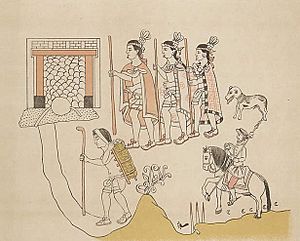
In 1519, a group of Spaniards led by Hernán Cortés arrived on the Mexican coast. They met the Totonac people, who were under Aztec rule. The Totonacs quickly told the Aztec Emperor, Moctezuma II, about the newcomers.
The Spaniards then met the Tlaxcaltecs, a Nahua group who had managed to stay independent from the Aztecs. After some fighting, the Tlaxcalans became allies with Cortés. This alliance was very important in the fight against the Aztecs. The Spanish and Tlaxcaltec forces marched on Aztec cities, freeing them. Finally, they reached the Aztec capital of Tenochtitlan.
At first, Moctezuma II welcomed them, but the Spaniards soon took him prisoner. When the Aztec nobles realized their ruler was a Spanish puppet, they attacked. The Spaniards were forced to flee the city and found safety in Tlaxcala. They gathered more forces and, with large Tlaxcaltec armies, laid siege to Tenochtitlan. The city eventually fell.
After this, the Spanish, now allied with some Aztecs, took over all the former Aztec lands. This new area was called New Spain. The Nahua people were seen as allies and were given some special rights and independence that other native groups did not have. Some historians believe the Nahua might have seen this as just another war between different Nahua groups at first.
Life under Spanish rule (1521–1821)
When the Spanish arrived, a new way of life began. Historians have studied this time a lot. In the early years, there wasn't much direct contact between Spaniards and native people. Christian missionaries tried to convert the Nahua to Catholicism. The Spanish also changed the system where native towns paid tribute and provided labor. This became the Encomienda system, where towns paid tribute to a Spanish encomendero.
Local Nahua rulers, called tlatoani, and noblemen kept some power. They helped gather tribute and labor for the Spaniards. Many Nahua leaders were baptized and took Christian names. They even used Spanish noble titles like don.
The Nahua quickly learned to write using the Latin alphabet. Within 20 years, they were writing texts in their own language. In 1536, the first university in the Americas, the Colegio de Santa Cruz de Tlatelolco, was opened. It was meant to train young Nahua noblemen to be priests who could speak Spanish, Latin, and Nahuatl.
As the Spanish expanded their rule, Nahua soldiers often helped them. They formed a large part of the Spanish armies that conquered other native groups like the Maya and Zapotecs.
Christian missionaries tried to stop native religious practices. Nahuas who didn't give up their old beliefs were punished. However, many Nahuas secretly blended their old beliefs with Christianity. They often practiced their own religion at home, especially in rural areas where Spanish presence was low.
Over time, Nahuatl absorbed many Spanish words, especially for new objects. However, the basic grammar of Nahuatl stayed the same. Nahuas started writing many legal documents in Nahuatl, like sales records and town council notes.
By the mid-16th century, the Spanish stopped training Nahua men to be priests. But in local communities, churches were still built. People formed groups called cofradías to support Christian saints and help with burials. Many Nahuas also started writing wills, which tell us a lot about their lives, families, and property.
In the later colonial period, Nahuatl showed more Spanish influence. Some Nahuas even started writing in a mix of Nahuatl and Spanish. They also created new types of documents called "primordial titles." These documents claimed their community's rights to land, often by telling local stories.
The Nahua people today
When Mexico became independent in 1821, the system that divided people by race was removed. The term "Indian" was no longer used by the government. This meant that Nahuas and other native groups lost some of the special protections they had under Spanish rule. They became more marginalized. Many native languages were lost as people faced pressure to speak Spanish.
In the 1800s, some Mexican leaders thought native people were "backward." They wanted to end communal land ownership, which was important for native identity. This led to laws that broke up community lands. This affected all native groups, including the Nahuas.
However, some native men became important figures. Benito Juárez, a Zapotec, became president of Mexico. Another important Nahua figure was Ignacio Manuel Altamirano (1834–93). He was a respected writer, politician, and diplomat. He believed that public education was key to improving Mexico.
How many Nahua people are there?
The Mexican government counts people by language, not by ethnicity. So, statistics for Nahuas usually only count Nahuatl speakers. Many Nahuas also speak Spanish, and some may not identify as Nahua in the census to avoid discrimination.
About 1.4 million people in Mexico speak Nahuatl. Around 190,000 of them speak only Nahuatl. The state of Guerrero has the highest number of people who speak only Nahuatl.
The largest groups of Nahuatl speakers are in Puebla, Veracruz, Hidalgo, San Luis Potosí, and Guerrero. Smaller groups are found in México State, Morelos, and Mexico City. Some Nahuatl speakers have also moved to the United States, especially in Texas, New York, and California.
Most Nahuatl speakers can also read and write in Spanish. On average, Nahuatl speakers have fewer years of education than the national average in Mexico.
Nahua culture
Economy: How they make a living
Many Nahua people are farmers. They use different methods, like plowing with horses or mules, or slash-and-burn farming. They grow crops like corn, wheat, beans, chili peppers, onions, tomatoes, and squash. Some Nahuas also raise sheep and cattle.
Language
The main languages are Nahuatl and Pipil.
Religion
The Nahua people have a rich history of religious beliefs, including those related to Aztec mythology. Today, most Nahuas are Christian, mainly Roman Catholic. However, their Christian practices often include influences from their ancient pre-Columbian beliefs.
Images for kids
See also
 In Spanish: Nahuas para niños
In Spanish: Nahuas para niños


